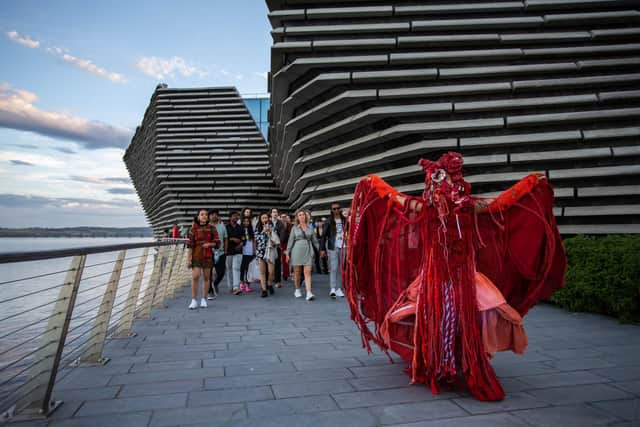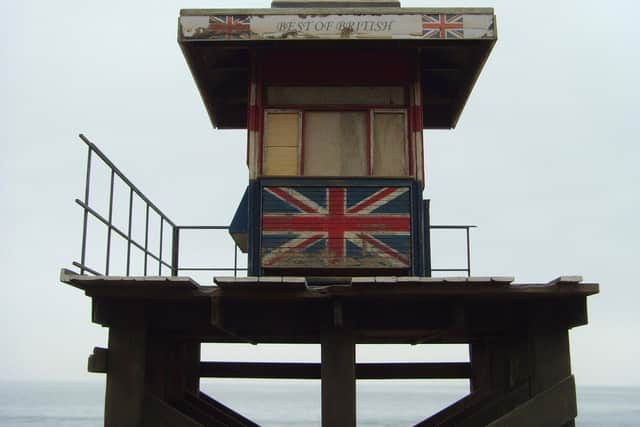Arts review of 2023: Susan Mansfield and Duncan Macmillan on the year in visual art
Lotte Glob: Eriboll Creatures, Kilmorack Gallery, near Beauly In March, the Kilmorack Gallery showed a spectacular collection of the work of veteran ceramicist Lotte Glob. Born in Denmark, for many years she has lived and worked above Loch Eriboll on the north coast. Her ceramics are very much in and of this landscape. “Of” it because she incorporates elements of the complex geology of the area to make her vividly coloured glazes and “in” it, too, because she has the eccentric habit of placing her work in the landscape, not only near her home, but in the surrounding mountains too. There they might well startle an unwary walker as this collection of work, Eriboll Creatures, consisted of an extraordinary phantasmagoria of imaginary marine monsters. DM
The Accursed Share, Talbot Rice Gallery, Edinburgh Under director Tessa Giblin and curator James Clegg, Talbot Rice Gallery has become the de facto home of ambitious themed group exhibitions. The Accursed Share has one of their most interesting and topical, bringing together work by an impressive range of contemporary artists on the subject of money. From Sammy Bajoli (Democratic Republic of Congo) turning copper shell casings into plant pots, to Anglo-German collaborators terrao proposing to use AI to make a forest self-governing, and Turner Prize winner Lubaina Himid’s seminal work Naming the Money, it was as much about transforming the problems as simply highlighting them. SM
Advertisement
Hide AdTartan, V&A Dundee In April, the V&A Dundee put on the biggest Tartan show for many years. One thing that came across simply because of the scale the show was what a vast subject Tartan is and what a chameleon it is, too. It is as endlessly variable in the purposes it serves as it is in its colours and patterns. It can be a badge of identity for a clan or regiment and can serve for the dressing up of the very grand, and, at least in the past, as the hard-wearing costume of the very humble. It has become a punk symbol of protest and an inspiration for the elegance of haute couture. All these contrasting uses and a good many more were explored in this stunning show. DM


Keg de Souza: Shipping Roots, Inverleith House, Edinburgh At Inverleith House in April, Keg de Souza created a fascinating exhibition that explored “the colonial legacy of plants”: how imperialism, either accidentally or by design, took plants from their native habitats to places where, intruders in long-established ecosystems, they often proved extremely disruptive. The prickly pear cactus was taken from Mexico to create field barriers in Australia with disastrous results, for instance. It then spread worldwide. The eucalyptus tree was taken from Australia as a quick growing hardwood and likewise spread across much of the world. The cochineal beetle, native to Mexico, provided the dye for the red coats of the empire’s soldiers. The British tried to cultivate it in Australia, but it was a very expensive failure. Clearly Nature has her own mind in such matters. DM
Art Night Dundee, various venues, Dundee For a single sun-drenched night in June, Dundee played host to the first full iteration of Art Night outside London. With a programme of ten new commissions plus a host of pop-up and community-led events, the city became a playground for art lovers. Highlights ranged from Heather Phillipson’s nature movie at Cooper Gallery in the West to Richey Carey conducting singers in the Baxter Pavillion to the East. With music programmed by Nabihah Iqbal issuing from the deck of the RSS Discovery and Emma Hart’s rave throbbing in the Greenmarket car park, Art Night was just as curator Helen Nisbet said it would be: remembered in a dream-like haze, like all the best parties. SM
Grayson Perry’s Smash Hits, National Gallery of Scotland, Edinburgh The blockbuster of the year was undoubtedly Grayson Perry’s Smash Hits. It was seen by 100,000 visitors and I think that number wasn’t just because of hype. People really did respond to the richness and complexity of his art. The show was dominated by his enormous tapestries. Visually arresting they present complex narratives of social commentary and engagement. Indeed, one of the biggest is directly inspired by Hogarth, not an obviously fashionable source of contemporary artistic inspiration. If you looked more closely, however, the pots were the stars of the show. They are beautiful but they too carry all sorts of commentary and it is often hilarious. This was an exhibition with much to admire, to engage with and to amuse. DM
Markéta Luskačová, Stills, Edinburgh Although the Prague-born photographer Markéta Luskačová has been based in the UK since the 1970s, her name is less well known than it should be, perhaps because she has been a woman working in a largely male-dominated world. This show, curated by Stills director Ben Harman working with Luskačová, drew on an archive of 45 years of top-notch documentary photography. Focussing on the theme of childhood, the showcase ranged from school playgrounds and cathedral choirs to urchins in a London market and festival processions in Slovakia. At every turn, Luskačová’s clear and compassionate eye had something interesting to show us. SM


Scottish Women Artists: 250 Years of Challenging Perception, Dovecot Studios, Edinburgh The artist Dame Ethel Walker once declared that “There is no such thing as a woman artist. There are only two kinds of artists – bad and good.” She had a point, but the premise of this excellent show seemed to be that until the playing field is levelled and the achievements of women artists recognised, their story needs be told. This show put on by the Fleming Collection set out to do just that in a fascinating and comprehensive way. Beginning with Catherine Read in the 18th century and going right up to the present with recent work by Sekai Machache, it included work by famous names including Anne Redpath, Joan Bradley and Elizabeth Blackadder, but also by many others who deserve to be better known. DM
Advertisement
Hide AdCharlie Stiven: Kiosk, Summerhall, Edinburgh Small objects which encapsulate big themes rarely work quite as well as the model kiosks of Charlie Stiven. The artist, who teaches at Edinburgh College of Art, makes meticulous models of boarded up kiosks inspired by, but not replicas of, European on-street retail booths which allude to the presence of bigger economic and political forces. The British kiosk, for example, with its peeling Union Jack, is marooned at the end of a post-Brexit pier, while three kiosks from Lviv are blackened by the debris of war. Perfectly housed in the big glass cases of the Lab Gallery, big themes were writ small in this show, wrapped in a geeky model-railway-enthusiast charm. SM
Sekai Machache: Svikiro, Mount Stuart, Isle of Bute Invited to take part in Mount Stuart’s contemporary art programme, Sekai Machache responded with her most ambitious body of work to date in September: a 45-minute film for the mail hall, and a series of shorter films screened all over the sumptuous neo-gothic mansion. Machache, who is Zimbabwean-Scottish and will represent Zimbabwe at next year’s Venice Biennale, proved herself easily ready for the big league with the scale and production values of this project, from its poetic text to its gorgeous costumes. In it, she explored themes of imagination, connection and hidden history, while populating Mount Stuart with a cast of talented black women created its own eloquent subtext. SM